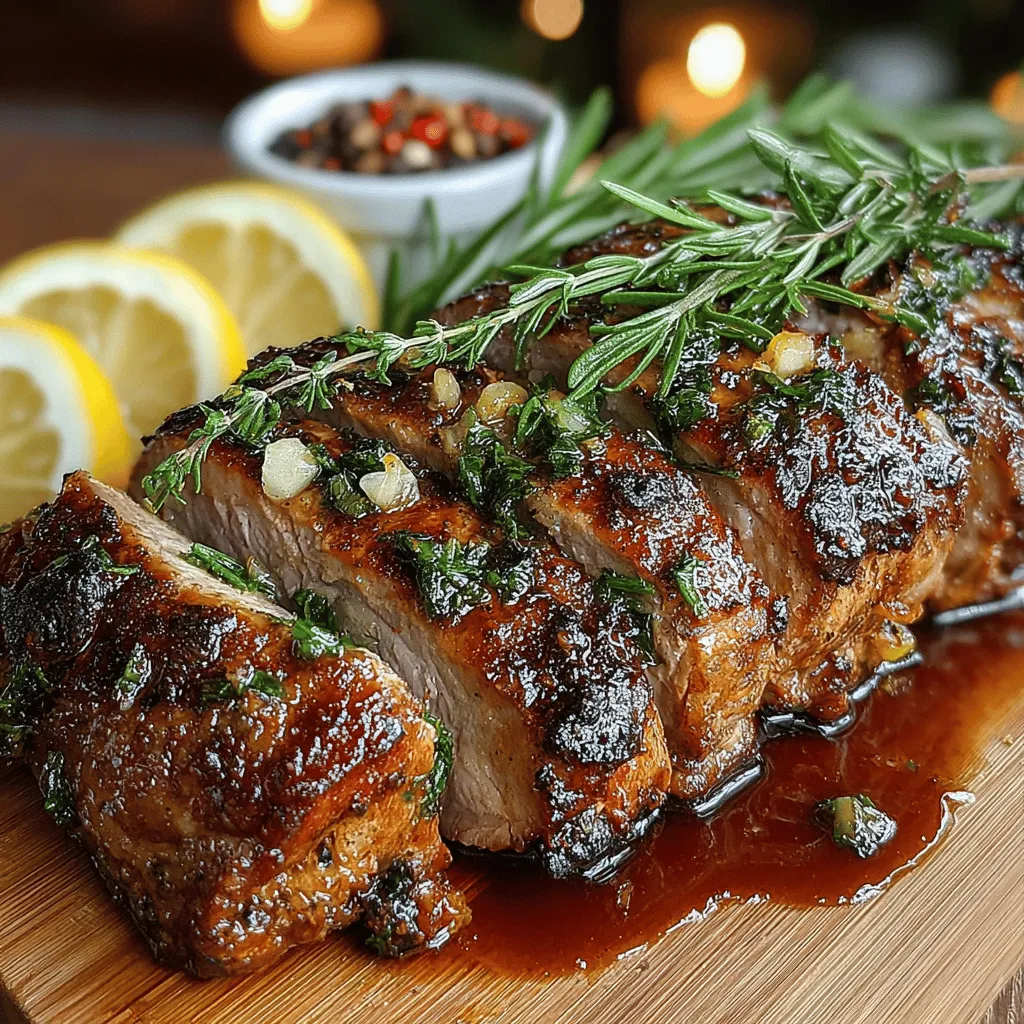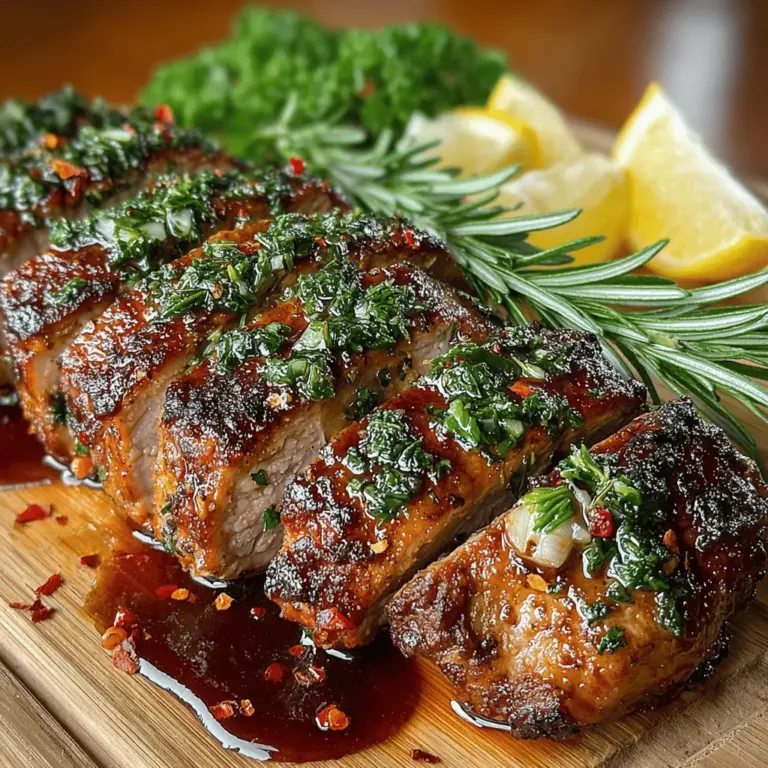Introduction
Pork tenderloin is celebrated in culinary circles for being one of the most versatile and tender cuts of meat available. This particular cut not only boasts a delicate texture but also serves as a blank canvas for a variety of flavors, making it an excellent choice for both casual family dinners and elegant gatherings. Among the myriad of ways to prepare pork tenderloin, the Garlic Herb Roasted Pork Tenderloin stands out for its simplicity, robust flavor, and an air of sophistication that will impress your guests without requiring hours spent in the kitchen.
The appeal of this recipe lies not just in its taste but also in its health benefits. Pork is a nutrient-rich meat that provides lean protein, essential vitamins, and minerals. When combined with fresh herbs and garlic, this dish transforms into a wholesome meal that is both nutritious and flavorful. The aromatic herbs and pungent garlic not only enhance the meat but also contribute their own health benefits, making this dish a perfect choice for health-conscious cooks.
Understanding Pork Tenderloin
Pork tenderloin is a long, thin strip of meat that runs along the spine of the pig. Known for its mild flavor and exceptional tenderness, this cut is often favored by chefs for its ability to absorb marinades and spices effectively. Its unique texture allows for a quick cooking time, making it an ideal option for weeknight meals or last-minute dinner parties.
From a nutritional standpoint, pork tenderloin stands out as a rich source of lean protein. A 3-ounce serving typically contains around 22 grams of protein, making it a fantastic option for those looking to maintain or build muscle. Additionally, it is packed with important vitamins and minerals, including B vitamins (such as B6 and B12), zinc, and phosphorus. These nutrients play vital roles in energy production, immune function, and overall health.
When shopping for pork tenderloin, there are a few tips to keep in mind to ensure you select the best quality cut. Look for tenderloins that are pink in color, with a firm texture and minimal fat. Avoid any cuts that appear overly dark or have an unpleasant odor. If possible, opt for pork that is labeled as “natural” or “organic,” as these options often come from pigs that have been raised without antibiotics or hormones, resulting in a cleaner and more flavorful product.
The Flavor Profile of Garlic Herb Roasted Pork Tenderloin
The magic of Garlic Herb Roasted Pork Tenderloin lies in its marinade, which features a harmonious blend of garlic, fresh herbs, olive oil, and Dijon mustard. Each ingredient plays a crucial role in contributing to the dish’s overall flavor profile.
Garlic is a central component, imparting its signature pungent and savory notes while also boasting numerous health benefits, including anti-inflammatory properties. Fresh herbs, such as rosemary, thyme, and parsley, each bring their own unique aromas and flavors to the table. Rosemary adds a woody depth, thyme introduces a subtle earthiness, and parsley provides a fresh, bright finish. The use of high-quality olive oil not only helps to bind the marinade but also enhances the overall richness of the dish, while Dijon mustard adds a tangy kick that balances the flavors beautifully.
Marinating the pork tenderloin is essential for achieving a depth of flavor and tenderness. By allowing the meat to soak in the marinade for a period of time, the flavors penetrate deeply, ensuring that each bite is bursting with taste. Additionally, the acids in the marinade help to break down the meat fibers, resulting in a juicy and tender final product.
Step-by-Step Guide to Preparing Garlic Herb Roasted Pork Tenderloin
Preparing the Ingredients
To create this delicious Garlic Herb Roasted Pork Tenderloin, you will need to gather the following ingredients:
– 1 to 1.5 pounds of pork tenderloin
– 4 cloves of garlic, minced
– 2 tablespoons fresh rosemary, chopped
– 2 tablespoons fresh thyme, chopped
– 2 tablespoons fresh parsley, chopped
– 1/4 cup olive oil
– 2 tablespoons Dijon mustard
– 1 lemon, juiced
– Salt and pepper to taste
Each ingredient plays a vital role in the overall success of the dish. The pork tenderloin serves as the main star, while the garlic and herbs create a flavorful ensemble that enhances the meat’s natural taste. Fresh herbs are particularly important; they contribute bright and vibrant notes that dried herbs simply cannot replicate. Investing in quality olive oil will also elevate the dish, providing a rich base that complements the other flavors beautifully.
Preheating the Oven
Before beginning the cooking process, it is crucial to preheat your oven to 400°F (200°C). This temperature is optimal for roasting pork tenderloin, allowing it to cook evenly and develop a beautiful caramelized crust while remaining juicy and tender inside. The high heat helps to lock in moisture, ensuring that the pork does not dry out during the cooking process.
Preparing the Marinade
To prepare the marinade, start by combining the minced garlic, chopped rosemary, thyme, and parsley in a mixing bowl. Next, add the olive oil, Dijon mustard, and lemon juice. Whisk the mixture together until well combined. Taste the marinade and feel free to adjust the flavors according to your preference. If you prefer a little more acidity, a splash of extra lemon juice can brighten the overall flavor. Similarly, if you enjoy a more robust garlic flavor, adding an additional clove could enhance the dish further.
Marinating the Pork Tenderloin
Once the marinade is prepared, it’s time to marinate the pork tenderloin. Place the tenderloin in a resealable plastic bag or a shallow dish and pour the marinade over the meat, ensuring it is thoroughly coated. Seal the bag or cover the dish and refrigerate for at least 30 minutes, although marinating for 2 hours or even overnight will yield even more flavorful results. The longer the pork sits in the marinade, the more the flavors will develop, and the more tender the meat will become.
As the pork tenderloin marinates, the ingredients will infuse the meat with their rich flavors, setting the stage for a deliciously savory dish that is sure to impress any palate. With the preparation steps completed, you are well on your way to creating a mouthwatering Garlic Herb Roasted Pork Tenderloin that can be enjoyed on any occasion.

Best Practices for Marinating
Marinating is a crucial step in the preparation of Garlic Herb Roasted Pork Tenderloin. To achieve the best results, consider the following best practices:
Time, Containers, and Temperature
– Time: Allow the pork tenderloin to marinate for at least 30 minutes to 2 hours. For optimal flavor, marinating overnight in the refrigerator enhances both the taste and tenderness of the meat.
– Containers: Use a non-reactive container such as glass or food-safe plastic. Avoid metal containers, as they can react with the acids in the marinade, affecting the flavor.
– Temperature: Always marinate in the refrigerator to keep the pork tenderloin at a safe temperature and prevent bacterial growth.
How Marinating Enhances Flavor Penetration and Tenderness
Marinating not only infuses the meat with delightful flavors but also helps to break down muscle fibers, resulting in a more tender texture. The combination of acidic ingredients (like vinegar or citrus juice) and oil helps to penetrate the meat, making it flavorful throughout rather than just on the surface.
Searing the Tenderloin
Importance of Searing: Creating a Flavorful Crust
Searing is a critical step that locks in the juices and creates a beautiful, golden-brown crust. This Maillard reaction not only enhances the visual appeal of the dish but also adds depth to the flavor profile.
Ideal Cooking Temperature and Timing for Perfect Searing
Heat a skillet over medium-high heat and add a tablespoon of oil. Once the oil is shimmering, carefully place the marinated pork tenderloin in the skillet. Sear it for about 2-3 minutes on each side until a rich brown crust forms. This will help retain the juices during roasting.
Roasting the Pork Tenderloin
Transferring to the Oven: Why Using an Oven-Safe Skillet is Beneficial
After searing, it’s essential to transfer the skillet directly to the oven. Using an oven-safe skillet allows for a smoother transition from stovetop to oven, maintaining the flavor and preventing the need for additional dishes.
Understanding Internal Temperature: Using a Meat Thermometer for Accuracy
To ensure perfectly cooked pork tenderloin, use a meat thermometer to check the internal temperature. Aim for an internal temperature of 145°F (63°C) for a juicy and tender result. This typically requires about 15-20 minutes of roasting, depending on the thickness of the tenderloin. Always insert the thermometer into the thickest part of the meat for the most accurate reading.
Resting the Meat
Explanation of the Resting Process: Why It’s Crucial for Juiciness
Resting the pork tenderloin after roasting is a vital step that allows the juices to redistribute throughout the meat. Cutting into it too soon can result in a dry texture, as the juices will spill out.
How Long to Rest the Pork and What to Cover It With
Allow the pork tenderloin to rest for 5-10 minutes after removing it from the oven. Cover it loosely with aluminum foil to keep it warm while it rests. This brief period enhances the overall juiciness and flavor of the final dish.
Slicing and Serving
Techniques for Slicing Pork Tenderloin into Medallions
Once rested, slice the pork tenderloin into medallions approximately 1-inch thick. Use a sharp knife and slice against the grain to ensure tenderness in each bite. This technique helps to break up the muscle fibers, resulting in a more enjoyable eating experience.
Serving Suggestions: Pairing with Sides, Garnishes, and Sauce Options
Pairing Suggestions for Garlic Herb Roasted Pork Tenderloin
Pair your Garlic Herb Roasted Pork Tenderloin with a variety of sides that complement its rich flavors:
– Recommended Side Dishes: Consider roasted vegetables, garlic mashed potatoes, or a fresh green salad. Each of these options brings out the herbaceous notes of the pork.
– Seasonal Vegetables and Grains: For a seasonal touch, serve with sautéed asparagus, Brussels sprouts, or a quinoa salad. The nutty flavors of grains and the freshness of vegetables balance the savory pork.
– Suggestions for Sauces or Glazes: A drizzle of balsamic reduction or a side of apple sauce can elevate the dish, adding a sweet contrast to the savory flavors. Alternatively, a creamy mustard sauce pairs beautifully, enhancing the herbaceous notes.
Storing and Reheating Leftovers
Best Practices for Storing Leftover Pork Tenderloin
If you have leftovers, store them in an airtight container in the refrigerator. Proper storage will keep the pork tender and flavorful. Ideally, consume the leftovers within 3-4 days for the best taste.
Tips for Reheating Without Losing Flavor and Moisture
To reheat, place the pork tenderloin in a preheated oven at 350°F (175°C) for about 10-15 minutes until warmed through. To retain moisture, consider adding a splash of broth or water to the bottom of the baking dish and covering it with foil. This method will help prevent the meat from drying out.
Conclusion
Garlic Herb Roasted Pork Tenderloin is a versatile and delightful dish that is perfect for family dinners, special celebrations, or meal prep. The combination of marinating, searing, and roasting creates a flavorful centerpiece that is sure to impress your guests. With simple techniques and accessible ingredients, you can elevate your cooking and create memorable meals to share with loved ones.
Don’t hesitate to try this recipe and experience the joy of cooking. Whether you’re preparing a weeknight dinner or hosting a gathering, this tender, herb-infused pork tenderloin will shine on your table. Enjoy the process and the delicious results that come from sharing great food with great company.

